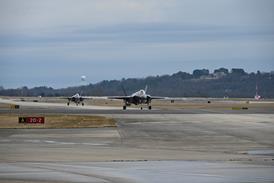Turning a commercial 767-200ER airframe into the first Italian tanker involves drastic surgery that begins with removal of the vertical and horizontal tails, as well as the lower Section 48, which includes the lower aft fuselage from the forward lip of the tailcone to the aft pressure bulkhead. Wing trailing-edge flaps are removed, while the entire aircraft is put on jacks and weighed.
Work also begins to cut out a large forward-fuselage section to provide space for the right-hand 3.9 x 2.8m (154 x 110in) cargo door and its support structure, as well as providing access for the installation of a strengthened main deck.
The rebuilding phase then gets under way with the installation of a strengthened Vought-built Section 48, complete with housing for the aerial-refuelling boom. Trailing-edge flaps are installed, as are the fittings for the wingtip hose-and-drogue refuelling pods.
Located slightly inwards from the inboard low-speed aileron hinge line, at wing station 960, the pod is supported by localised strengthening of two ribs and two new, strengthened ribs. The standard wing-tank jettison pipe is extended 3m to provide fuel to the pods, "so it is not a huge modification for us in this area", says tanker programmes operations director Brad Gorsuch.
The forward upper-fuselage crown section, aft of the flightdeck, is also modified to take the UARRSI universal aerial-refuelling receptacle and its slipway. The strengthened cargo deck and floor, built in two pieces and then spliced together, is installed and smoke and rigid cargo barriers fitted, along with the cargo door. The smoke barrier separates the palletised seating section in the aft cabin from the freight section, which runs forward from around mid-fuselage to the rigid cargo barrier installed aft of the Section 41 bulkhead. As both civil and military certification is required for the new aircraft, provisions are being made in the Italian tanker for Type 1 exit doors.
The vertical and horizontal tails are then replaced, and the remote air-refuelling operator (RARO) station installed in the forward cabin. The 767's updated RARO II features improved liquid-crystal displays, a three-dimensional virtual-reality helmet and other features to help the operator handle the updated boom. The boom, meanwhile, is improved with automatic load alleviation, independent quick disconnect and fly-by-wire flight control system.
Forward of the refuelling boom, between the aftmost lower-lobe auxiliary fuel tank and the aft pressure bulkhead, is a pressurised housing for the centreline hose drum unit. Fuel is supplied through a common line that can be switched to feed the boom or the hose drum unit through a "Y" valve. The fuel line to the boom feeds through a reinforced cutout in the lower hemisphere of the aft pressure bulkhead.
Source: Flight International























